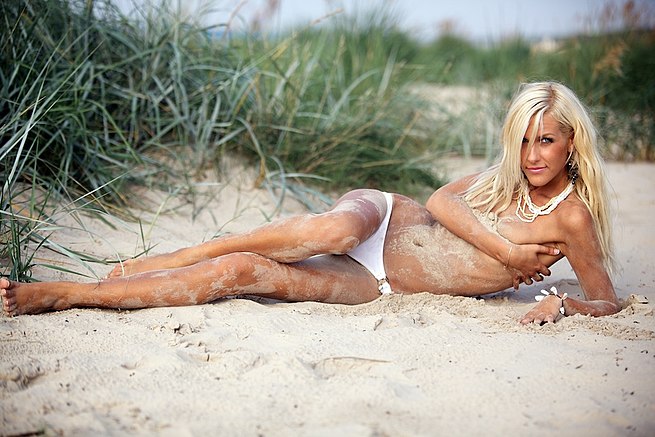
Main Difference
The main difference between Monokini and Bikini is that the Monokini is a topless swimsuit designed by Rudi Gernreich and Bikini is a two piece women’s swimwear
-
Monokini
The monokini, designed by Rudi Gernreich in 1964, consisting of only a brief, close-fitting bottom and two thin straps, was the first women’s topless swimsuit. His revolutionary and controversial design included a bottom that “extended from the midriff to the upper thigh” and was “held up by shoestring laces that make a halter around the neck.” Some credit Gernreich’s design with initiating, or describe it as a symbol of, the sexual revolution.Gernreich designed the monokini as a protest against a repressive society. He didn’t initially intend to produce the monokini commercially, but was persuaded by Susanne Kirtland of Look to make it available to the public. When the first photograph of a frontal view of Peggy Moffitt wearing the design was published in Women’s Wear Daily on June 3, 1964, it generated a great deal of controversy in the United States and other countries. Gernreich sold about 3000 suits, but only two were worn in public. The first was worn publicly on June 22, 1964 by Carol Doda in San Francisco at the Condor Nightclub, ushering in the era of topless nightclubs in the United States, and the second at a beach in Chicago in July 1964 by artist’s model Toni Lee Shelley, who was arrested.
Some manufacturers and retailers refer to modern monokini swimsuit designs as a topless swimsuit, topless bikini, or unikini.
-
Bikini
A bikini is typically a women’s two-piece swimsuit featuring two triangles of fabric on top, similar to a bra and covering the woman’s breasts, and two triangles of fabric on the bottom, the front covering the pelvis but exposing the navel, and the back covering the buttocks. The size of the top and bottom can vary from full coverage of the breasts, pelvis, and buttocks, to very skimpy designs like a thong or G-string that cover only the areolae and mons pubis, but expose the buttocks.
In May 1946, fashion designer Jacques Heim from Paris released a two-piece swimsuit design that he named the Atome. Like swimsuits of the era, it covered the wearer’s navel, and it failed to attract much attention. Clothing designer Louis Réard introduced his new, smaller design in July. He named the swimsuit after the Bikini Atoll, where the first public test of a nuclear bomb had taken place only four days before. His skimpy design was risque, exposing the wearer’s navel and much of her buttocks. No runway model would wear it, so he hired a nude dancer from the Casino de Paris to model it at a review of swimsuit fashions.Due to its controversial and revealing design, the bikini was accepted very slowly by the public. It gained increased exposure and acceptance as film stars like Brigitte Bardot, Raquel Welch, and Ursula Andress wore them and were photographed on public beaches and seen in film. In many countries the design was banned from beaches and other public places.The minimalist bikini design became common in most Western countries by the mid-1960s as both swimwear and underwear. By the late 20th century it was widely used as sportswear in beach volleyball and bodybuilding. There are a number of modern stylistic variations of the design used for marketing purposes and as industry classifications, including monokini, microkini, tankini, trikini, pubikini, and skirtini. A man’s single-piece brief swimsuit may also be called a bikini. Similarly, a variety of men’s and women’s underwear types are described as bikini underwear.
The bikini has gradually gained wide acceptance in Western society. By the early 2000s, bikinis had become a US$811 million business annually, and boosted spin-off services such as bikini waxing and sun tanning.
-
Monokini (noun)
The lower part of a bikini without the upper part (i.e., topless).
-
Monokini (noun)
A one-piece swimsuit, which may cover both the chest and the crotch (as contrasted with a bikini, which consists of two pieces).
-
Bikini (noun)
A brief two-piece bathing suit worn by women.
-
Bikini (noun)
A brief bathing suit worn by men.
-
Bikini (noun)
an atoll in the Marshall Islands, in the western Pacific, used by the US between 1946 and 1958 as a site for testing nuclear weapons.
